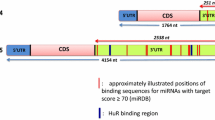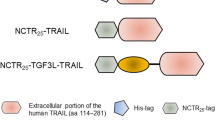Abstract
We analyzed a novel bifunctional fusion protein, CD40ed–CD95Led, consisting amino-terminally of the extracellular domain of CD40 and carboxy-terminally of the extracellular domain of CD95L. On cells lacking CD40L, this fusion protein is poorly active with respect to CD95 activation [median effective dose (ED50)>1 μg/ml], but it stimulates CD95 signaling with high efficiency upon binding to membrane-expressed CD40L (ED50<1 ng/ml). Thus, cell surface immobilization mediated by the CD40 part of the molecule unmasks the high-latent, CD95-stimulating capacity of the otherwise poorly active CD95L fusion protein. Moreover, interaction of the CD40 part of CD40ed–CD95Led with CD40L prevents the activation of cellular CD40. The CD40ed–CD95Led fusion protein therefore simultaneously blocks antiapoptotic CD40 activation and induces CD95-mediated apoptosis. Indeed, T47D cells displaying an antiapoptotic autocrine CD40–CD40L signaling loop were significantly more sensitive toward CD40ed–CD95Led than toward soluble CD95L artificially activated by crosslinking. Fusion proteins of RANK and CD95L (RANKed–CD95Led) and CD40 and tumor necrosis factor-related apoptosis inducing ligand (TRAIL) (CD40ed–TRAILed), with domain architectures similar to CD40ed–Cd95Led, displayed RANKL-dependent CD95 and CD40L-dependent TRAILR2 activation, respectively, indicating the principle feasibility of this fusion protein design.






Similar content being viewed by others
Abbreviations
- ed:
-
extracellular domain
- TRAIL:
-
tumor necrosis factor-related apoptosis inducing ligand
References
Locksley RM, Killeen N, Lenardo MJ (2001) The TNF and TNF receptor superfamilies: integrating mammalian biology. Cell 104:487–501
Fesik SW (2000) Insights into programmed cell death through structural biology. Cell 103:273–282
Wajant H, Pfizenmaier K, Scheurich P (2003) Tumor necrosis factor signaling. Cell Death Differ 10:45–65
Wajant H, Moosmayer D, Wuest T, Bartke T, Gerlach E, Schonherr U, Peters N, Scheurich P, Pfizenmaier K (2001) Differential activation of TRAIL-R1 and -2 by soluble and membrane TRAIL allows selective surface antigen-directed activation of TRAIL-R2 by a soluble TRAIL derivative. Oncogene 20:4101–4106
Schneider P, Holler N, Bodmer JL, Hahne M, Frei K, Fontana A, Tschopp J (1998) Conversion of membrane-bound Fas(CD95) ligand to its soluble form is associated with downregulation of its proapoptotic activity and loss of liver toxicity. J Exp Med 187:1205–1213
Dhein J, Daniel PT, Trauth BC, Oehm A, Moller P, Krammer PH (1992) Induction of apoptosis by monoclonal antibody anti-APO-1 class switch variants is dependent on cross-linking of APO-1 cell surface antigens. J Immunol 149:3166–3173
Vilcek J, Feldmann M (2004) Historical review: cytokines as therapeutics and targets of therapeutics. Trends Pharmacol Sci 25:201–209
Wittrant Y, Theoleyre S, Chipoy C, Padrines M, Blanchard F, Heymann D, Redini F (2004) RANKL/RANK/OPG: new therapeutic targets in bone tumours and associated osteolysis. Biochim Biophys Acta 1704:49–57
Mackay F, Ambrose C (2003) The TNF family members BAFF and APRIL: the growing complexity. Cytokine Growth Factor Rev 14:311–324
Beattie MS (2004) Inflammation and apoptosis: linked therapeutic targets in spinal cord injury. Trends Mol Med 10:580–583
Wajant H, Gerspach J, Pfizenmaier K (2005) Tumor therapeutics by design: targeting and activation of death receptors. Cytokine Growth Factor Rev 16:55–76
Almasan A, Ashkenazi A (2003) Apo2L/TRAIL: apoptosis signaling, biology, and potential for cancer therapy. Cytokine Growth Factor Rev 14:337–348
Walczak H, Miller RE, Ariail K, Gliniak B, Griffith TS, Kubin M, Chin W, Jones J, Woodward A, Le T, Smith C, Smolak P, Goodwin RG, Rauch CT, Schuh JC, Lynch DH (1999) Tumoricidal activity of tumor necrosis factor-related apoptosis-inducing ligand in vivo. Nat Med 5:157–163
Ashkenazi A, Pai RC, Fong S, Leung S, Lawrence DA, Marsters SA, Blackie C, Chang L, McMurtrey AE, Hebert A, DeForge L, Koumenis IL, Lewis D, Harris L, Bussiere J, Koeppen H, Shahrokh Z, Schwall RH (1999) Safety and antitumor activity of recombinant soluble Apo2 ligand. J Clin Invest 104:155–162
Lawrence D, Shahrokh Z, Marsters S, Achilles K, Shih D, Mounho B, Hillan K, Totpal K, DeForge L, Schow P, Hooley J, Sherwood S, Pai R, Leung S, Khan L, Gliniak B, Bussiere J, Smith CA, Strom SS, Kelley S, Fox JA, Thomas D, Ashkenazi A (2001) Differential hepatocyte toxicity of recombinant Apo2L/TRAIL versions. Nat Med 7:383–385
Jo M, Kim TH, Seol DW, Esplen JE, Dorko K, Billiar TR, Strom SC (2000) Apoptosis induced in normal human hepatocytes by tumor necrosis factor-related apoptosis-inducing ligand. Nat Med 6:564–567
Leverkus M, Sprick MR, Wachter T, Mengling T, Baumann B, Serfling E, Brocker EB, Goebeler M, Neumann M, Walczak H (2003) Proteasome inhibition results in TRAIL sensitization of primary keratinocytes by removing the resistance-mediating block of effector caspase maturation. Mol Cell Biol 23:777–790
Samel D, Muller D, Gerspach J, Assohou-Luty C, Sass G, Tiegs G, Pfizenmaier K, Wajant H (2003) Generation of a FasL-based proapoptotic fusion protein devoid of systemic toxicity due to cell-surface antigen-restricted activation. J Biol Chem 278:32077–32082
Wuest T, Gerlach E, Banerjee D, Gerspach J, Moosmayer D, Pfizenmaier K (2002) TNF-selectokine: a novel prodrug generated for tumor targeting and site-specific activation of tumor necrosis factor. Oncogene 21:4257–4265
Bremer E, Samplonius DF, van Genne L, Dijkstra MH, Kroesen BJ, de Leij LF, Helfrich W (2005) Simultaneous inhibition of epidermal growth factor receptor (EGFR) signaling and enhanced activation of tumor necrosis factor-related apoptosis-inducing ligand (TRAIL) receptor-mediated apoptosis induction by an scFv:sTRAIL fusion protein with specificity for human EGFR. J Biol Chem 280:10025–10033
Bremer E, Kuijlen J, Samplonius D, Walczak H, de Leij L, Helfrich W (2004) Target cell-restricted and -enhanced apoptosis induction by a scFv:sTRAIL fusion protein with specificity for the pancarcinoma-associated antigen EGP2. Int J Cancer 109:281–290
Bauer S, Adrian N, Williamson B, Panousis C, Fadle N, Smerd J, Fettah I, Scott AM, Pfreundschuh M, Renner C (2004) Targeted bioactivity of membrane-anchored TNF by an antibody-derived TNF fusion protein. J Immunol 172:3930–3939
Watts TH (2005) TNF/TNFR family members in costimulation of T cell responses. Annu Rev Immunol 23:23–68
Quezada SA, Jarvinen LZ, Lind EF, Noelle RJ (2004) CD40/CD154 interactions at the interface of tolerance and immunity. Annu Rev Immunol 22:307–328
Siegmund D, Wicovsky A, Schmitz I, Schulze-Osthoff K, Kreuz S, Leverkus M, Dittrich-Breiholz O, Kracht M, Wajant H (2005) Death receptor-induced signaling pathways are differentially regulated by gamma interferon upstream of caspase 8 processing. Mol Cell Biol 25:6363–6379
Voorzanger-Rousselot N, Blay JY (2004) Coexpression of CD40 and CD40L on B lymphoma and carcinoma cells: an autocrine anti-apoptotic role. Leuk Lymphoma 45:1239–1245
Pham LV, Tamayo AT, Yoshimura LC, Lo P, Terry N, Reid PS, Ford RJ (2002) A CD40 signalosome anchored in lipid rafts leads to constitutive activation of NF-kappaB and autonomous cell growth in B cell lymphomas. Immunity 16:37–50
Storz M, Zepter K, Kamarashev J, Dummer R, Burg G, Haffner AC (2001) Coexpression of CD40 and CD40 ligand in cutaneous T-cell lymphoma (mycosis fungoides). Cancer Res 61:452–454
Rudner J, Jendrossek V, Lauber K, Daniel PT, Wesselborg S, Belka C (2005) Type I and type II reactions in TRAIL-induced apoptosis—results from dose–response studies. Oncogene 24:130–140
Martin DA, Zheng L, Siegel RM, Huang B, Fisher GH, Wang J, Jackson CE, Puck JM, Dale J, Straus SE, Peter ME, Krammer PH, Fesik S, Lenardo MJ (1999) Defective CD95/APO-1/Fas signal complex formation in the human autoimmune lymphoproliferative syndrome, type Ia. Proc Natl Acad Sci USA 96:4552–4557
Hilliard B, Wilmen A, Seidel C, Liu TS, Goke R, Chen Y (2001) Roles of TNF-related apoptosis-inducing ligand in experimental autoimmune encephalomyelitis. J Immunol 166:1314–1319
Lamhamedi-Cherradi SE, Zheng SJ, Maguschak KA, Peschon J, Chen YH (2003) Defective thymocyte apoptosis and accelerated autoimmune diseases in TRAIL−/− mice. Nat Immunol 4:255–260
Schneider P, Thome M, Burns K, Bodmer JL, Hofmann K, Kataoka T, Holler N, Tschopp J (1997) TRAIL receptors 1 (DR4) and 2 (DR5) signal FADD-dependent apoptosis and activate NF-kappaB. Immunity 7:831–836
Bergmeyer HU (ed) (1984) Methods of enzymatic analysis, vol. 3, 3rd edn. Wiley Verlag Chemie, Weinheim, pp 416–456
Acknowledgements
This work was supported by Deutsche Forschungsgemeinschaft (Sonderforschungsbereich 487, project B7), Deutsche Krebshilfe (grant 10-1751-Wa 3), Wilhelm–Sander–Stiftung (grant 2003.120.1), and Interdisziplinären Zentrum für Klinische Forschung Wuerzburg (project B-32). We were further supported by APOXIS S.A. (Epalinges, Switzerland).
Author information
Authors and Affiliations
Corresponding author
Additional information
Klaus Pfizenmaier and Harald Wajant contributed equally to this work.
Rights and permissions
About this article
Cite this article
Assohou-Luty, C., Gerspach, J., Siegmund, D. et al. A CD40–CD95L fusion protein interferes with CD40L-induced prosurvival signaling and allows membrane CD40L-restricted activation of CD95. J Mol Med 84, 785–797 (2006). https://doi.org/10.1007/s00109-006-0073-1
Received:
Accepted:
Published:
Issue Date:
DOI: https://doi.org/10.1007/s00109-006-0073-1




